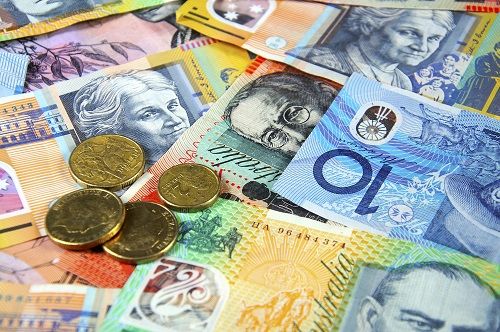Australian Dollar Retreats from the Weekly High, Focus Shifts to US PPI
- Markets in 2026: Will gold, Bitcoin, and the U.S. dollar make history again? — These are how leading institutions think
- US Q4 Earnings Season Set to Begin: Can US December CPI Data Bolster Rate Cut Case? [Weekly Preview]
- Gold Price Forectast: XAU/USD rises above $4,600 on US rate cut expectations, Fed uncertainty
- Trump’s Tariff Ruling Lands Today: Market to Rise or Fall — The Decision Will Tell
- Gold Price Forecast: XAU/USD declines to near $4,450 as safe-haven demand eases
- US Dollar Index steadies above 99.00 ahead of Retail Sales, PPI data

Australian Dollar maintains its position below the 0.6500 psychological level.
Australia’s Wage Price Index (Q3) rose by 1.3% as expected and 4.0% annually.
US Dollar faces pressure as US inflation slowed more than anticipated.
The Australian Dollar (AUD) pulls back from the weekly high, hovering below the major level around 0.6500 on Wednesday. Tuesday's data unveiled a more pronounced deceleration in US inflation than initially predicted, leading to a substantial decline in the US Dollar (USD). Consequently, the AUD/USD pair saw a notable increase.
Australia’s Wage Price Index came in on Wednesday, revealing that quarterly labor cost inflation grew 1.3% as expected compared to the previous reading of 0.8%. The year-over-year data showed an increase of 4.0% more than the anticipated 3.9%. Moreover, The Australian jobs data will be published on Thursday, providing further insights.
Australia's Westpac Consumer Confidence report indicated a significant drop in consumer sentiment for November. The Reserve Bank of Australia (RBA) depicted a tough economic landscape in its Monetary Policy Statement (MPS) last Friday, citing persistent inflation challenges and a sluggish Australian economy. The increasing pressure on data-guided policy adjustments will likely pose a challenge for the central bank board.
The Dollar Index (DXY) recorded a 1.50% decline in the previous session, hitting its lowest point since early September. The Greenback faced additional pressure from increased risk appetite and a downward trend in US Treasury bonds. The US 10-year yield experienced a significant drop to an eight-week low at 4.43%.
Australian Dollar remains below a psychological level amid RBA’s uncertainty over policy rates
Australia’s Westpac Consumer Confidence declined by 2.6% in November, swinging from the previous growth of 2.9%.
RBA Assistant Governor (Economic) Marion Kohler stated that the decline in inflation is expected to be slower than initially anticipated. This is attributed to the persistent high level of domestic demand and robust pressures from labor and other costs. Kohler emphasized the need for a tighter policy to address the challenges posed by elevated inflation.
RBA highlighted the challenges stemming from persistent inflationary pressures and a sluggish domestic economy in its Monetary Policy Statement (MPS) last Friday.
RBA board acknowledges the financial struggles of many households. Budgets are indeed feeling the squeeze. In a twist of economic dynamics, the central bank painted a mixed picture by raising its inflation and GDP growth forecasts.
RBA increased the Official Cash Rate (OCR) from 4.10% to a 12-year high of 4.35%, responding to the latest Monthly Consumer Price Index (YoY) for September, which indicated a notable increase of 5.6% compared to the expected 5.4% growth.
Australia’s TD Securities Inflation (YoY) eased at 5.1% in September from 5.7% prior.
Economists at the National Australia Bank (NAB) anticipate another 25 basis points hike in February following the Q4 inflation data. Additionally, NAB believes rate cuts will unlikely commence until November 2024.
The US-Sino Presidential meeting is on the horizon, and US President Joe Biden aims to rebuild military-to-military connections with China. The much-anticipated face-to-face between Biden and Chinese President Xi Jinping is scheduled for Wednesday during the Asia-Pacific Economic Cooperation summit in San Francisco., marking their first in-person meeting in a year.
The US Consumer Price Index (CPI) for October showed lower readings than expected, with the annual rate slowing from 3.7% to 3.2%, falling below the consensus forecast of 3.3%. The monthly CPI reduced to 0.0% from 0.4%.
The US Core CPI rose by 0.2% below the expectations of 0.3%, and the annual rate decreased to 4.0% from 4.1% prior.
US Monthly Budget Statement reported a deficit of $67B in October, compared to the expected deficit of $65B.
US preliminary US Michigan Consumer Sentiment data for November showed a dip in the mood among consumers. It fell to 60.4 from 63.8 in the previous month.
Australian Dollar hovers below the 0.6500 major level followed by the 38.2% Fibonacci retracement
The Australian Dollar trades around 0.6490 on Wednesday aligned to the immediate resistance at 0.6500 psychological level, followed by the 38.2% Fibonacci retracement at 0.6508.
On the downside, the AUD/USD pair could meet the support at the 21-day Exponential Moving Average (EMA) lined up with the major level at 0.6400.
AUD/USD, Source: FXStreet.
Read more
* The content presented above, whether from a third party or not, is considered as general advice only. This article should not be construed as containing investment advice, investment recommendations, an offer of or solicitation for any transactions in financial instruments.




